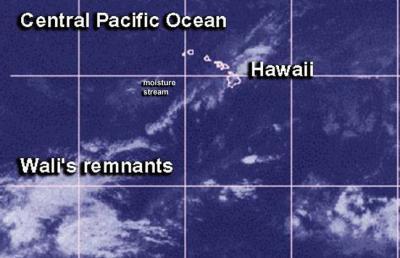On July 19, NOAA's Central Pacific Hurricane Center noted that Wali didn't even make it to the Big Island, but moisture associated with the storm did. NOAA's GOES-West satellite captured an image of the remnant low southwest of the Big Island, and a moisture stream that extended over it.
That remnant moisture was enough to cause the local National Weather Service office to issue an early morning flash flood watch on July 19. An infrared image from NOAA's GOES-West satellite showed the moisture stream as a diagonal line of clouds extending from what was the center of the remnants of Wali. During the afternoon, the National Weather Service issued a flood advisory for the eastern half of the island as a result of thunderstorms that generated heavy rainfall.

This infrared image from NOAA's GOES-West satellite on July 19 showed the moisture stream as a diagonal line of clouds extending from what was the center of the remnants of Wali.
(Photo Credit: Image : NOAA)
The CPHC said "The moisture moving over the Big Island today (July 19) is ahead of the actual low level remnants of Wali. The low level remnants of Wali remain more than 500 miles southwest of the Big Island this evening. That being said, the tropical moisture over the Big Island today, and the remnants of Wali are associated, and it is this combination of features that will keep the threat of heavy rain and thunderstorms over and near the islands for the next 48 hours."
More tropical moisture is moving over Hawaii today, July 21, and that triggered another flash flood watch for all of the Hawaiian Islands. The Flash Flood Watch remains in effect until 6 p.m. Hawaii Standard Time on July 21. At 3:05 a.m. HST (9:05 a.m. EDT) on July 21, the National Weather Service in Honolulu noted "atmospheric conditions continue to be favorable for locally heavy rain to develop due to the presence of an upper level trough near the islands and ample tropical moisture. The potential for flash flooding remains elevated."
Source: NASA/Goddard Space Flight Center